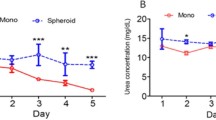Summary
A simple and highly reproducible method was established for the culturing of adult rat and human hepatocytes as multicellular aggregates (spheroids). Purified rat and human liver parenchymal cells were cultured on nontissue culture (bacteriological) polystyrene petri dishes on a rotating platform. After an overnight incubation, the cells were found to form multicellular aggregates. The aggregates became spheroidal in shape after several days in culture. Histological sections of the spheroids showed an organized structure consisting of squamated cells on the outermost layer and cuboidal cells in the interior. Cellular structures characteristic of hepatocytes in the liver in vivo including bile canaliculi, peroxisomes, Golgi boides, abundant mitochondria, and rough and smooth endoplasmic reticulum were observed with electron microscopy. The spheroids were found to be viable up to the longest time studied of approx. 1 month in culture as demonstrated by their adherence and growth on collagen-coated substratum. The morphological resemblance between hepatocytes cultured as spheroids and the liver in vivo suggests that the spheroids may be a useful in vitro experimental model of the liver. Our simple method should allow hepatocytes to be cultured as spheroids easily in any laboratory equipped for cell culture. Our study here also is the first to report the culturing of human hepatocytes as spheroids.
Similar content being viewed by others
References
Green, C. E.; Segall, H. J.; Byard, J. L. Metabolism, cytotoxicity, and genotoxicity of the pyrrolizidine alkaloid senecionine in primary cultures of rat hepatocytes. Toxicol. Appl. Pharmacol. 60:176–185; 1981.
Guigoz, Y.; Werffeli, P.; Favre, D., et al. Aggregate cultures of fetal rat liver cells: development and maintenance of liver gene expression. Biology of the Cell 60:163–171; 1987.
Kane, R. E.; Tector, J.; Brems, J. J., et al. Sulfation and glucuronidation of acetaminophen by cultured hepatocytes reproducingin vivo sex-differences in conjugation on Matrigel and Type 1 collagen. In Vitro Cell. Dev. Biol. 27A:953–960; 1991.
Koide, N.; Sakaguchi, K.; Koide, Y., et al. Formation of multicellular spheroids composed of adult rat hepatocytes in dishes with positively charged surfaces and under other nonadherent environment. Exp. Cell Res. 186:227–235; 1990.
Landry, J. D.; Bernier, C.; Ouellet, R., et al. Spherical aggregate culture of rat liver cells: histiotypic reorganization, biomatrix deposition, and maintenance of functional activities. J. Cell Biol. 101:914–923; 1985.
Li, A. P. Growth of mammalian cells as unattached cultures on nontissue culture plates. J. Tissue Culture Meth. 6:71–74; 1980.
Li, A. P.; Myers, C. A.; Roque, M. A., et al. Epidermal growth factor induction of DNA synthesis in primary cultures of human hepatocytes. In Vitro Cell. Dev. Biol. 27A:831–833; 1991.
Li, A. P.; Roque, M. A.; Beck, D. J., et al. Isolation and culturing of hepatocytes from human livers. J. Tissue Culture Meth. 14:139–146; 1992.
Li, A. P.; Myers, C. A.; Kaminski, D. L. Gene transfer in primary cultures in human hepatocytes. In Vitro Cell. Dev. Biol. In press; 1992a.
Loretz, L. J.; Wilson, A. G. E.; Li, A. P. Promutagen activation by freshly isolated and cryopreserved rat hepatocytes. Environ. Mol. Mutag. 12:335–341; 1988.
Loretz, L. J.; Li, A. P.; Flye, M. W., et al. Optimization of cryopreservation procedures for rat and human hepatocytes. Xenobiotica 19:489–498; 1989.
Reese, J. A.; Byard, J. L. Isolation and culture of adult hepatocytes from liver biopsies. In Vitro 17:935–940; 1981.
Sakaguchi, K.; Koide, N.; Asano, K., et al. Promotion of spheroid assembly of adult rat hepatocytes by some factor(s) present in the initial 6-hour conditioned medium of the primary culture. Pathobiol. 59:351–356; 1991.
Shinji, N.; Koide, N.; Tsuji, T. Glycosaminoglycans partially substitutes for proteoglycans in spheroid formation of adult rat hepatocytes in primary culture. Cell Struct. Funct. 13:179–188; 1988.
Tong, J. Z.; Bernard, O.; Alvarez, F. Long-term culture of rat liver cell spheroids in hormonally defined media. Exp. Cell Res. 189:87–92; 1990.
Tong, J. Z.; De Lagausie, P.; Furlan, V., et al. Long-term culture of adult rat hepatocyte spheroids. Exp. Cell Res. 200:326–332; 1992.
Yuhas, J. M.; Li, A. P. Growth fraction as the major determinant of multicellular tumor spheroid growth rate. Cancer Res. 38:1528–1532; 1978.
Yuhas, J. M.; Li, A. P.; Martinez, A. O., et al. A simplified method for production and gowth of multicellular tumor spheroids. Cancer Res. 37:3639–3643; 1977.
Author information
Authors and Affiliations
Rights and permissions
About this article
Cite this article
Li, A.P., Colburn, S.M. & Beck, D.J. A simplified method for the culturing of primary adult rat and human hepatocytes as multicellular spheroids. In Vitro Cell Dev Biol - Animal 28, 673–677 (1992). https://doi.org/10.1007/BF02631045
Accepted:
Issue Date:
DOI: https://doi.org/10.1007/BF02631045




